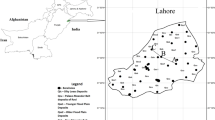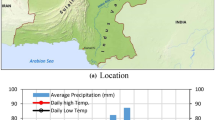Abstract
This article aims to build geotechnical maps (GMs) of soil in its natural deposition using the most efficient interpolation techniques based on statistical analyses using a comprehensive field and laboratory-investigated soil database. GMs were developed based on standard penetration test (SPT-N), shear wave velocity (Vs), plasticity index (P.I), activity (A), linear shrinkage (L.S), cohesion (c), frictional angle (Φ), and chemical contents in conjunction with the recommendation for foundation design. The performance of various interpolation models was evaluated using key performance indices (KPIs) revealing that inverse distance weighting (IDW) interpolation based on the modified shepherd method demonstrated a significant validation with the least prediction error and thus opted for the development of GMs. The created GMs reveal the predomination of fine-grained soil at shallow layers (1.5–3.0 m) with SPT-N and Vs ranging between 0–20 and 0–300 (m/s); P.I between 0- < 17; A-value between 0- < 1.25; L.S between 0- < 7; c-value between 0-3psi; and Φ between 28–30°. The deeper stratum beyond m 3.0 m depth is dominated by coarse-grained soil, cobbles, and boulders. Moreover, the chemical contents at 1.5 m strata fall under the permissible thresholds. For the integrated GMs at multiple strata, the efficacy of GMs was quantified in terms of the root means square error (RMSE) and mean absolute error (MAE) that vary from 0.14 to 1.98, while the Nash Sutcliffe model efficiency coefficient (NSE) and Pearson coefficient (PC) ranged between 0.83–0.99. In addition, the pertinent recommendation maps for foundation design were developed and problematic areas were highlighted that need due attention.



















Similar content being viewed by others
Data availability
Data will be available upon reasonable request.
References
Adimalla N, Qian H (2020) Introductory Editorial Special Issue:“Groundwater quality and contamination and the application of GIS.” Environ Earth Sci 79(18):1–2
Alasadi, LA, Abojassim, AA (2021) Mapping of Natural Radioactivity in Soil Samples of Kufa Districts, Iraq Using GIS Technique
Al-Ani H, Eslami-Andargoli L, Oh E, Chai G (2013) Categorising geotechnical properties of surfers paradise soil using geographic information system (GIS). GEOMATE Journal 5(10):690–695
Antipov VV, Ofrikhter VG (2021) Development of nondestructive techniques for preliminary soil foundations geotechnical assessment. Japanese Geotechnical Society Special Publication 9(5):215–220
Bargaoui ZK, Chebbi A (2009) Comparison of two kriging interpolation methods applied to spatiotemporal rainfall. J Hydrol 365(1–2):56–73
Basu D, Misra A, Puppala AJ (2015) Sustainability and geotechnical engineering: perspectives and review. Can Geotech J 52(1):96–113
Canakci H, Hamed M, Celik F, Sidik W, Eviz F (2016) Friction characteristics of organic soil with construction materials. Soils Found 56(6):965–972
Chai T, Draxler RR (2014) Root mean square error (RMSE) or mean absolute error (MAE)?–Arguments against avoiding RMSE in the literature. Geoscientific Model Development 7(3):1247–1250
Chaminé HI, Afonso MJ, Trigo JF, Freitas L, Ramos L, Carvalho JM (2021) Site appraisal in fractured rock media: coupling engineering geological mapping and geotechnical modelling. European Geologist Journal 51:30–38
Das JT et al (2018) Establishing a threshold sustainability index for a geotechnical construction. IFCEE 2018:222–232
Feng S, Vardanega PJ (2019) Correlation of the hydraulic conductivity of fine-grained soils with water content ratio using a database. Environmental Geotechnics 6(5):253–268
Halder K, Chakraborty D (2019) Effect of interface friction angle between soil and reinforcement on bearing capacity of strip footing placed on reinforced slope. Int J Geomech 19(5):06019008
Hytiris N, Stott R, McInnes K (2014) The importance of site investigation in the construction industry: a lesson to be taught to every graduate civil and structural engineer. World Trans Eng Technol Educ 12(3):414–419
Ijaz N, Dai F, ur Rehman Z (2020) Paper and wood industry waste as a sustainable solution for environmental vulnerabilities of expansive soil: A novel approach. J Environ Manage 262:110285
Ijaz Z, Zhao C, Ijaz N, Ijaz A (2021) Spatial mapping of geotechnical soil properties at multiple depths in Sialkot region. Pakistan Environmental Earth Sciences 80(24):1–16
Ijaz, Z, Zhao, C, Ijaz, N, Rehman, ZU, Ijaz, A (2022a) Novel application of Google earth engine interpolation algorithm for the development of geotechnical soil maps: a case study of mega-district. Geocarto Int 1–21
Ijaz N, urRehman Z, Ijaz Z (2022b) Recycling of paper/wood industry waste for hydromechanical stability of expansive soils: A novel approach. J Clean Prod 348:131345
Ijaz N, Ye W, ur Rehman Z, Ijaz Z (2022c) Novel application of low carbon limestone calcined clay cement (LC3) in expansive soil stabilization: An eco-efficient approach. J Clean Prod 371:133492
Ijaz N, Ye W, Rehman ZU, Ijaz Z, Junaid MF (2022d) New binary paper/wood industry waste blend for solidification/stabilisation of problematic soil subgrade: macro-micro study. Road Materials and Pavement Design 1-18
Ishikawa T, Yoshimi M, Isobe K, Yokohama S (2021) Reconnaissance report on geotechnical damage caused by 2018 Hokkaido Eastern Iburi earthquake with JMA seismic intensity 7. Soils Found 61(4):1151–1171
Kamran M, Bian J, Li A, Lei G, Nan X, Jin Y (2021) Investigating Eco-Environmental Vulnerability for China-Pakistan Economic Corridor Key Sector Punjab Using Multi-Sources Geo-Information. ISPRS Int J Geo Inf 10(9):625
Karra K, Kontgis C, Statman-Weil Z, Mazzariello JC, Mathis M, Brumby SP (2021, July) Global land use/land cover with Sentinel 2 and deep learning. In 2021 IEEE international geoscience and remote sensing symposium IGARSS. IEEE, pp. 4704–4707
Khalid MH, Alshameri B, Abid U (2021) Application of Kriging for development of SPT N value contour maps and USCS-based soil type qualitative contour maps for Islamabad. Pakistan Environmental Earth Sciences 80(11):1–13
Khan B, Jamil A, Nawaz MS (2021) Effect of Seasonal Variation and Meteorological Parameters on the Environmental Noise Pollution in the Selected Areas of Rawalpindi and Islamabad, Pakistan.
Kim HS, Ji Y (2022) Three-dimensional geotechnical-layer mapping in Seoul using borehole database and deep neural network-based model. Eng Geol 297:106489
Liu D, Liu H, Wu Y, Zhang W, Wang Y, Santosh M (2022) Characterization of geo-material parameters: Gene concept and big data approach in geotechnical engineering. Geosystems and Geoenvironment 1(1):100003
Lohpaisankrit W, Prasanchum H (2022) Catchment-Scale Flood Hazard Mapping in the Lower Areas of Lam Pao River Basin. Thailand Engineering Access 8(1):53–60
Look BG (2007) Handbook of geotechnical investigation and design tables. Taylor & Francis
Mahmood K, Farooq K, Memon SA (2016) One dimensional equivalent linear ground response analysis—a case study of collapsed Margalla Tower in Islamabad during 2005 Muzaffarabad Earthquake. J Appl Geophys 130:110–117
Mannan, A., Yongxiang, F., Khan, T. U., Nizami, S. M., Mukete, B., Ahmad, A., ... & Wali Muhammad, M. (2021). Urban Growth Patterns and Forest Carbon Dynamics in the Metropolitan Twin Cities of Islamabad and Rawalpindi, Pakistan. Sustainability 2021, 13, 12842
Martínez-Graña AM, Goy JL, Zazo C, Silva PG (2016) Soil map and 3D virtual tour using a database of soil-forming factors. Environmental Earth Sciences 75(21):1–19
Moaveni, M, Butt, AA, Gundapuneni, S, Groves, AD, Widener, SM (2022) Geotechnical Investigation of Urban Roads with Composite Pavement Structures Using Destructive and Non-destructive Testing. In Advances in Transportation Geotechnics IV. Springer, Cham, pp. 807–818
Mochtar HIB, Mochtar NEB (2018) The Effect of Cracks Propagation on Cohesion and Internal Friction Angle for High Plasticity Clay. Int J Appl Eng Res 13(5):2504–2507
Moriyama, M. (Sep. 2014). GCOM–C1/SGLI Land Surface Temperature Product Algorithm Theoretical Basis Document (Version 1). Retrieved from https://suzaku.eorc.jaxa.jp/GCOM_C/data/ATBD/ver1/LST-ATBD_2014.pdf. Accessed Jan 2022
Muñoz Sabater, J., (2019): ERA5-Land monthly averaged data from 1981 to present. Copernicus Climate Change Service (C3S) Climate Data Store (CDS). (<date of access>). https://doi.org/10.24381/cds.68d2bb30
Ortigão JAR (2020) Soil mechanics in the light of critical state theories: an introduction. CRC Press
Pachauri AK, Pant M (1992) Landslide hazard mapping based on geological attributes. Eng Geol 32:81–100
Panagos P, Borrelli P, Meusburger K, Yu B, Klik A, Lim KJ, ... Ballabio C (2017) Global rainfall erosivity assessment based on high-temporal resolution rainfall records. Scientific Reports 7(1):1–12
Prins LT, Andresen KJ (2021) A geotechnical stratigraphy for the shallow subsurface in the Southern Central Graben. North Sea Engineering Geology 286:106089
Ray R, Kumar D, Samui P, Roy LB, Goh ATC, Zhang W (2021) Application of soft computing techniques for shallow foundation reliability in geotechnical engineering. Geosci Front 12(1):375–383
Raza F, Alshameri B, Jamil SM (2021) Engineering aspect of sustainability assessment for geotechnical projects. Environ Dev Sustain 23(4):6359–6394
Sanchez PA et al (2009) Digital soil map of the world. Science 325:680–681
Searle, R., McBratney, A., Grundy, M., Kidd, D., Malone, B., Arrouays, D., ... & Andrews, K. (2021). Digital soil mapping and assessment for Australia and beyond: A propitious future. Geoderma Regional, 24, e00359
Selcer P (2015) Fabricating unity: The FAO-UNESCO soil map of the world. Historical Social Research/Historische Sozialforschung 174–201
Shogaki T, Nakano Y (2022) Geotechnical investigation of the Naval dry dock at the Mietsu Naval Facility World Heritage Site. Japan Soils and Foundations 62(1):101096
Thaimo, F, Ekolu, SO, Quainoo, H (2021) Standard relationship between plasticity index and linear shrinkage: revisited. Proceedings of the Institution of Civil Engineers-Geotechnical Engineering, pp. 1–9
Ting MZY, Wong KS, Rahman ME, Joo MS (2021) Cyclic compressive behavior of limestone and silicomanganese slag concrete subjected to sulphate attack and wetting-drying action in marine environment. Journal of Building Engineering 44:103357
ur Rehman Z, Khalid U (2021) Reuse of COVID-19 face mask for the amelioration of mechanical properties of fat clay: A novel solution to an emerging waste problem. Sci Total Environ 794:148746
ur Rehman, Khalid U, Ijaz N, Mujtaba H, Haider A, Farooq K, Ijaz Z (2022) Machine learning-based intelligent modeling of hydraulic conductivity of sandy soils considering a wide range of grain sizes. Eng Geol 311:106899
Watabe Y, Noguchi T (2011) Site-investigation and geotechnical design of D-runway construction in Tokyo Haneda Airport. Soils Found 51(6):1003–1018
Wu XZ (2013) Trivariate analysis of soil ranking-correlated characteristics and its application to probabilistic stability assessments in geotechnical engineering problems. Soils Found 53:540–556
Xu W, Wang Q, Chen R (2018) Spatio-temporal prediction of crop disease severity for agricultural emergency management based on recurrent neural networks. GeoInformatica 22(2):363–381
Yaseen M, Naseem AA, Ahmad J, Mehmood M, Anjum MN (2021) Integrated Approach for Inventories and Quantitative Assessment of Geological and Paleontological Sites from Precambrian to Quaternary Successions in the Salt Range. Pakistan Geoheritage 13(2):1–24
Žížala D, Minařík R, Skála J, Beitlerová H, Juřicová A, Rojas JR, ... Zádorová T (2022) High-resolution agriculture soil property maps from digital soil mapping methods, Czech Republic. Catena 212:106024
Author information
Authors and Affiliations
Contributions
Zain Ijaz: Conceptualization, Methodology, Validation, Software, Formal Analysis, Writing—Original Draft.
Cheng Zhao: Supervision, Project, Administration, Review, and editing.
Nauman Ijaz: Conceptualization, Validation, Formal analysis, Investigation, Writing—Original Draft.
Zia-ur-Rehman: Methodology, Formal analysis, Validation, Software, Review, and editing.
Aashan Ijaz: Methodology, Visualization, Formal analysis, Review, and editing.
Corresponding author
Ethics declarations
Ethical approval
Not applicable.
Competing interests
The authors have no competing interests in the submission of this manuscript.
Additional information
Communicated by H. Babaie.
Publisher's note
Springer Nature remains neutral with regard to jurisdictional claims in published maps and institutional affiliations.
Rights and permissions
Springer Nature or its licensor (e.g. a society or other partner) holds exclusive rights to this article under a publishing agreement with the author(s) or other rightsholder(s); author self-archiving of the accepted manuscript version of this article is solely governed by the terms of such publishing agreement and applicable law.
About this article
Cite this article
Ijaz, Z., Zhao, C., Ijaz, N. et al. Statistical evaluation of multiple interpolation techniques for spatial mapping of highly variable geotechnical facets of soil in natural deposition. Earth Sci Inform 16, 105–129 (2023). https://doi.org/10.1007/s12145-022-00924-2
Received:
Accepted:
Published:
Issue Date:
DOI: https://doi.org/10.1007/s12145-022-00924-2




